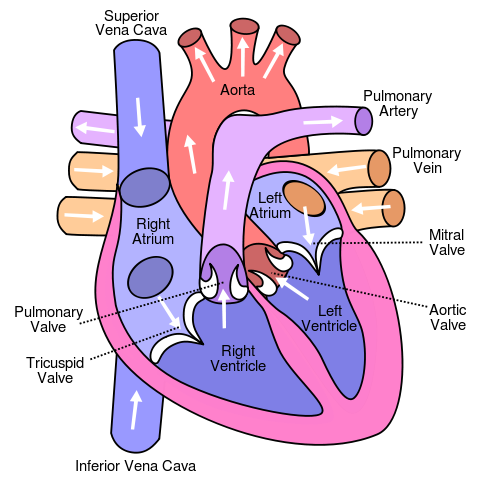The heart beats and pushes blood to the organs of the body, the blood carries oxygen and sustains life. The heart is the most incredible workaholic! Even when the body is at rest it pushes from 4.5 to 5 liters of blood for 1 minute. Over the course of a human life lasting about 70 years, through the cardiac muscular pump pass about 185,000,000 liters of blood. Fantastic, isn't it? And the heart weighs less than 300 grams.
At the boundary between the heart and the blood vessels coming out of it there are two valves. The first separates it from the beginning of the largest artery - the aorta and is called aortic valve. The second is located at the boundary between the right half of the heart and the pulmonary artery - the large blood vessel that carries blood to the lungs called pulmonary valve. Between the left atrium and left ventricle is the mitral valve and between the right atrium and right ventricle - the tricuspid valve. The purpose of the the heart cavities is to take the blood. That which comes from the veins is taken by the right atrium and from the lungs by the left atrium. Then the blood is pushed to the organs of the human body through muscle contractions of the left and right ventricle.
Electrical conduction system of the heart is one that through electrical pulses sets and leads to the cardiac muscle the signal for generation of its autonomous rhythm in other words the pulse. The cells that create pulses are located in the sino-atrial node (Nodus sinuatrialis) into the right atrium just below the place where the superior vena cava flows in. From thence the electrical excitation is transmitted through the musculature of the atrium to the atrioventricular node (Nodus atrioventricularis) which conducts the pulse with a delay to the musculature of the chamber. The strength and frequency of the heart contractions are governed by the autonomic nervous system (sympathetic and parasympathetic). Thereby are caused simultaneous contractions at various place within the heart which leads to an increase of the pressure in the heart cavities (atria and chambers). In healthy people the daytime heart rate should be between 60 and 80 beats per minute, and at night not less than 45 beats per minute. To maintain the life of the body the heart throbs constantly. For a year it performs about 40 million beats. The weak current which cardiac muscle generates is detected and recorded by the apparatus known as ElectroCardioGraphs (ECG).
Although all the blood of the human body passes through the heart nature has decided that the muscle pump must be fed separately. In order to live the heart receives blood from two major arteries - the coronary arteries. They go out from the beginning of the aorta immediately after the aortic valve of the left ventricle. One of them still at its beginning is divided into two powerful branches. Their branches form a sort of crown hence the name of the disease so widespread today - coronary, Coronary Artery Disease (CAD) also known as Ischemic Heart Disease (IHD). When the flow of oxygenated blood to the heart muscle decreases even for fractions of a second it goes into a state of the so-called oxygen starvation (ischemia). To overcome this condition the heart rate is increased. This is implemented in cooperation with the chemoreceptors located in the aortic arch. The chemoreceptors are peculiar physiological chemical analyzers measuring the saturation of the blood with oxygen, carbon dioxide and its alkali-acid value (pH). If they do not comply with the set norms of nature, starts an additional mechanism controlled by the brain that says by sympathetic division of the autonomic nervous system the heart rate to be raised in order to be achieved better supply of the heart and brain with blood. In a state of ischemia start heart problems which may deteriorate the functions of the muscle pump and depending on the duration of ischemia it may be followed by a heart attack. When this ischemic state is overcome a signal from the brain is sent to the heart through the vagus nerve so as the heart rate to be lowered.

